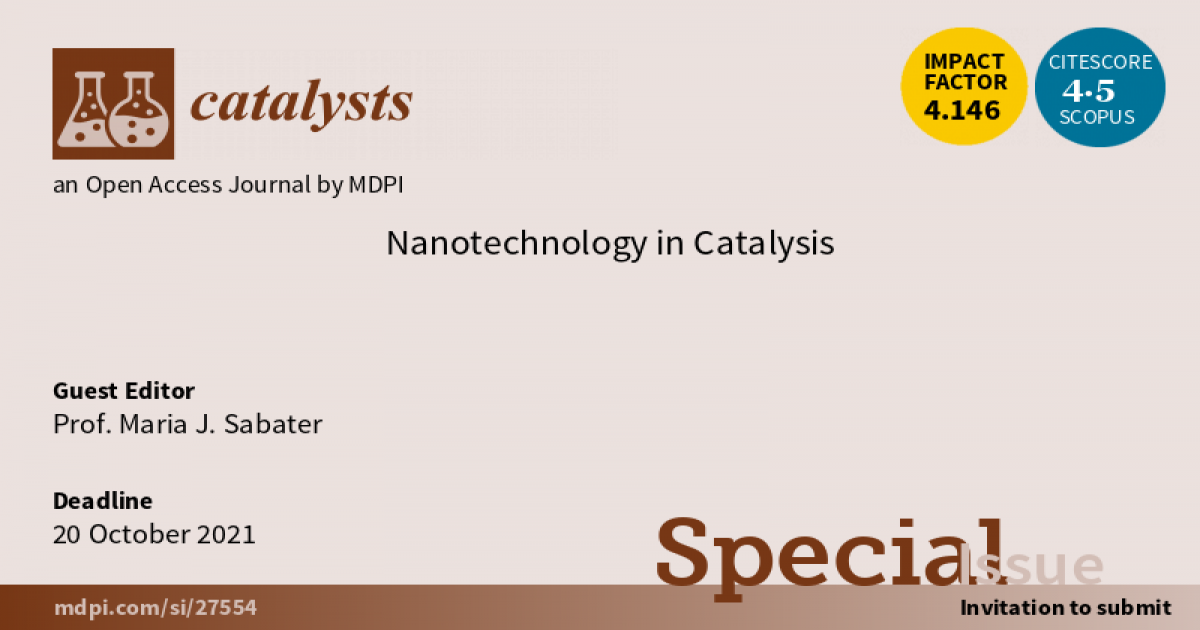Nanotechnology in Catalysis
A special issue of Catalysts (ISSN 2073-4344). This special issue belongs to the section "Nanostructured Catalysts".
Deadline for manuscript submissions: closed (20 October 2021) | Viewed by 17833

Special Issue Editor
Interests: catalysis; materials; redox chemistry; one-pot; fine chemistry; CO2 valorization
Special Issues, Collections and Topics in MDPI journals
Special Issue Information
Dear Colleagues,
The evolution of catalysis is associated to the development of nanoscience and nanotechnology, which has the potential to design, synthesize and control the catalysts at nanometer and sub-nanometer length scale. The enormous efficiency of these nanocatalysts has to do with a) the increasing surface-to-volume ratio with decreasing particle size, as well as b) with quantum confinement effects, which can influence the chemical features of sufficiently small particles. Other atomic characteristics such as the chemical composition will be also critical to achieve a benefit at the level of catalytic activity and selectivity.
Taking into account that synthetic heterogeneous catalysts are the basis of industrial chemistry, this issue will collect fundamental research in heterogeneous catalysis. In particular, design, preparation and characterization of nanocatalysts (nanoparticles and nanoclusters) for clean energy research (ranging from hydrogen and liquid fuel production from fossil and renewable resources to clean combustion technologies), nanocatalysis for environmental chemistry and nanocatalysis for clean processes (i.e. fine chemistry and large-scale industrial applications).
Prof. Maria J. Sabater
Guest Editor
Manuscript Submission Information
Manuscripts should be submitted online at www.mdpi.com by registering and logging in to this website. Once you are registered, click here to go to the submission form. Manuscripts can be submitted until the deadline. All submissions that pass pre-check are peer-reviewed. Accepted papers will be published continuously in the journal (as soon as accepted) and will be listed together on the special issue website. Research articles, review articles as well as short communications are invited. For planned papers, a title and short abstract (about 100 words) can be sent to the Editorial Office for announcement on this website.
Submitted manuscripts should not have been published previously, nor be under consideration for publication elsewhere (except conference proceedings papers). All manuscripts are thoroughly refereed through a single-blind peer-review process. A guide for authors and other relevant information for submission of manuscripts is available on the Instructions for Authors page. Catalysts is an international peer-reviewed open access monthly journal published by MDPI.
Please visit the Instructions for Authors page before submitting a manuscript. The Article Processing Charge (APC) for publication in this open access journal is 2700 CHF (Swiss Francs). Submitted papers should be well formatted and use good English. Authors may use MDPI's English editing service prior to publication or during author revisions.
Keywords
- Nanocatalyst
- Nanoclusters
- Nanoparticles
- Active site
- Design
- Selectivity
- Energy
- Environment
- Fine chemistry
- Large scale production





